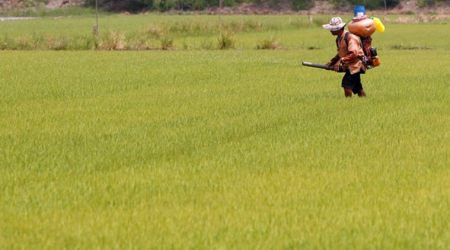 On top of all this we now have repeated droughts and floods — problems that are compounded by climate change.
On top of all this we now have repeated droughts and floods — problems that are compounded by climate change.
In the last 20 years, according to the government’s statistics, more than three lakh farmers have committed suicide in India. The situation of the farmers was never very good to begin with, but has been steadily declining and has reached its nadir right now. That is why we are seeing spontaneous eruptions of farmers’ agitations in state after state across the country. Gradually, these spontaneous agitations are getting organised and now, a coordinated all-India farmers’ movement is beginning to take shape which promises to be the beginning of one of the most significant farmers’ movement in the history of this country.
The question is: What has brought the farmers to their present state of desperation? The roots of this crisis, in my opinion, lie in the Green Revolution and the policies adopted therein. The situation has also been exacerbated by the government’s apathy towards the poor in general and towards farmers and rural folk in particular. The Green Revolution led agriculture towards chemical fertilisers, pesticides, irrigation through large dams and massive irrigation projects. This did lead to higher yields initially and, therefore, that period became known as the Green Revolution with most of the gains coming from the introduction of hybrid variety seeds.
However, with chemical fertilisers and hybrid seeds came the problems of resistance in pests and that led to the wider use of pesticides and also of higher potency. This infused poison in the food — especially for farmers, who also inhale the pesticides and, therefore, the higher incidence of cancer and other diseases — it also led to higher input costs and thereafter a gradual decline in productivity because of soil depletion. The chemical fertilisers added only a few chemicals like nitrogen, potassium and phosphorus to the soil without replenishing it with micro-nutrients and the pesticides kill even the soil bacteria. Eventually, the productivity started coming down and with greater use of pesticides, the input cost began to increase. Simultaneously, canals and canal irrigation also led to water-logging and a substantial part of the land became wasteland. In areas which were not irrigated by canals, there was a rise in the unregulated and unsustainable usage of tubewells to mine groundwater, leading its levels to fall rapidly. This led to even deeper tubewells, adding once again to the input costs for the farmers.
The Bhakra Dam was famously called one of the “temples of modern India” by Jawaharlal Nehru and has often been regarded as a boon to agriculture. Many large irrigation projects were thereafter taken up on similar lines, the most famous being the Sardar Sarovar project in Gujarat, which has been called the lifeline of the state by successive chief ministers. That project has taken up more than 90 per cent of Gujarat’s irrigation budget for the last 50 years and today irrigates less than 2 lakh hectares of agricultural land which is roughly 10 per cent of what was promised. It still doesn’t irrigate any part of Kuchh or Saurashtra — the arid regions for which it was supposedly made. If instead of this, even half this money had been spent on rain-water harvesting by giving every village of Gujarat a couple of crores for small check dams, every inch of agricultural land in Gujarat would have been irrigated many years ago.
On top of all this we now have repeated droughts and floods — problems that are compounded by climate change. We must also note that the government has fixed minimum support prices (MSP) for just wheat and rice, not for other crops and the MSP so fixed is just about adequate for farmers to meet their costs without giving even minimum wages for their own labour. The Swaminathan Commission had gone into this issue of MSP and had recommended that it should be extended to all crops and should be at least 50 per cent above the average cost price of farmers in each state. Despite a promise by the BJP in its manifesto to implement the Swaminathan Commission’s recommendations, nothing has been done. In fact, there have been successive cutbacks in the funds allocated to the MGNREGA and other such schemes.
Payments for the loss of crops during droughts and floods have not been made despite loan waivers and the ever-greening of loans to big industrialists, who have defaulted on payments to the tune of thousands of crores, by banks. It is only after widespread agitations that some state governments have decided to waive loans to farmers.
However, this is only a temporary solution. If farmers are to be rescued from this crisis we desperately need to change the whole agriculture policy and move it towards organic farming, irrigation by rain-water harvesting and micro-water irrigation, shifting from chemical to organic fertilisers, which will also use less pesticides. It may be noted that contrary to popular belief, the government’s data shows that the productivity from organically farmed lands is no less than those farmed with chemicals and pesticides. In addition, the Swaminathan Committee’s recommendations must be implemented which will require a considerable amount of money. But that money has to be found. Some of it could come by way of discontinuing the subsidy on chemical fertilisers and some from stopping large irrigation schemes which come at a huge cost and deliver very little.
In India, 50 per cent of the people are still dependent, directly or indirectly, on farming. We cannot ignore their plight anymore. We have been sowing the seeds of the farmers’ distress for a long time. Unless we quickly get our act together, we must be prepared to face the consequences. In any food crisis, it is the top of the food chain that suffers the most. In the case of farmer’s distress, the top of food chain is us — the end consumer.

